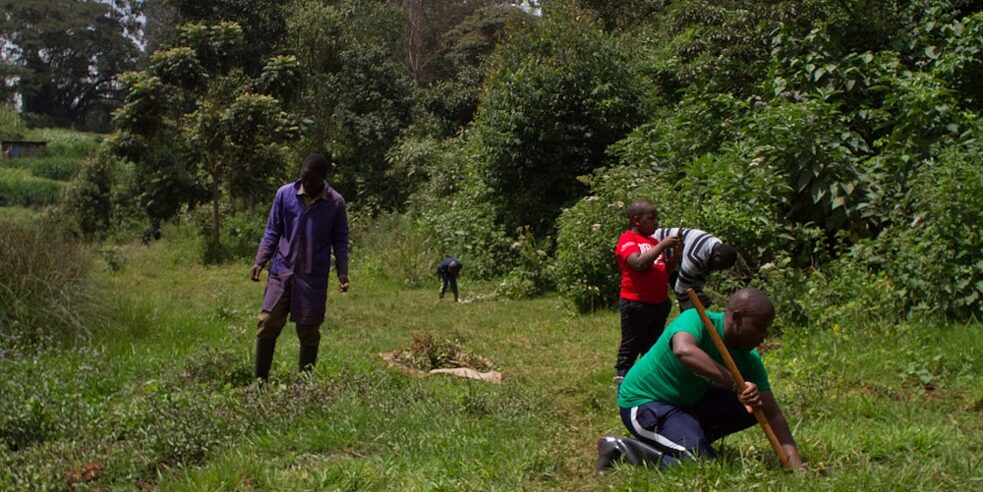The Case of Ondiri Swamp
Citizen Environmentalism is not Dead

If you were driving down the slick, new, multi-laned Southern Bypass, the urban superhighway that forms a giant arc around the lower half of Nairobi, you would pass by one of the most important urban wetlands in Nairobi likely without even a second glance.
That would be Ondiri Swamp. Upon first glance, it looks like a lush, sunken meadow left to bloom, but upon a closer look, you’d see that it is a marsh covered with a spongy mat of floating peat thick enough to walk on. Ondiri is about the size of a large pond—less than two kilometers around the perimeter—but it is not only the main water source for Kikuyu town, a small commuter town on the outskirts of Nairobi, but also a source for the Nyongara River, which then feeds into the Nairobi and Athi Rivers, two major sources of water for Kenya’s rapidly growing capital.
Despite its significance to Kikuyu and the greater Nairobi area, most people who grew up in Kikuyu town don’t know about Ondiri Swamp, or really care to, according to Samuel Njoroge, founder of the Kikuyu-based tour company Rhodes Tours. He grew up about three plots away from the swamp, but says, “Most people here don’t know much about it, even though they live so close.” That morning he’d asked a waitress as she brought him his morning cup of tea when was the last time she had been to Ondiri. She said it must have been when she was in primary school, when they went on a field trip.
Sam is a member of Friends of Ondiri Swamp, an organization comprised of volunteers dedicated to protecting and revitalizing Ondiri Swamp, but also to get people in Kikuyu interested in the wetlands. Even though wetlands make up a tiny proportion of Kenya’s surface area—2.5 percent and declining—they provide habitats for a diverse array of species, purify water of toxins, and sequester carbon. Wetlands also absorb water in the rainy season and release it gradually during the dry season, something which will only become more important as Nairobi replaces forested areas with buildings and roads, and flooding grows more severe each year.
Unfortunately, Ondiri is plagued by the same risks that other wetlands around the world are, including polluting industrial effluent, improper sewage disposal, as well as agricultural run-off excessive water extraction, and invasion by exotic species. At a certain point, local apartment managers began regularly piping raw sewage from trucks directly into the swamp to avoid costs associated with proper disposal channels. Friends of Ondiri volunteers lobbied local authorities to take action, and when that failed, took matters into their own hands by taking turns keeping watch by Ondiri at night and reporting instances of illegal dumping to the police. Several arrests have taken place, and their efforts have led to a visible improvement in the water quality, as indicated by the slow return of native flora and fauna.
However, the bulk of their impact is made not through antagonistic vigilance but rather through simple but time-consuming connections with other residents of Kikuyu like them. Take, for example, the riparian landowners, some of whom had planted eucalyptus trees—a fast-growing but water-draining exotic species—while others had established greenhouses that crept much too close to the swamp’s border. By speaking one-on-one with riparian landowners, listening to their concerns and educating them about the importance of the swamp and how it works, volunteers won their support, to the point that some began voluntarily cutting down their own eucalyptus trees and others shuttering their own greenhouses.
Sustainability does not happen only on a national or international stage. In fact, it is small-scale, community-based efforts that are not only effective at protecting local ecosystems but help us visualize what sustainability is all about, after all: valuing resources in a way that makes them available for future generations to value.
As they educate Kikuyu residents about revitalizing the swamp, Friends of Ondiri volunteers are also organizing to have the wetlands fenced off as a state-protected area and designated as an ecotourism site, something Friends of Ondiri founder David Wakogy has advocated for years. Sam’s small contribution to the cause as the owner of a tour company has been to provide tours of Ondiri. Another volunteer (who is passionate about biking) has laid out plans for bike paths that circle the swamp. Others who participate in Friends of Ondiri’s regular tree planting are cultivating fruit trees that will take years to bear fruit.
This kind of conservation is an act of collective imagination, one that does not simply seek to keep the swamp from getting dirty, and not just to revert it to its previous state, but rather to teach Kikuyu residents about why it is important and transform it into a place of greater value to the people who live near it than it has had before.
This story has two kinds of happy endings. Ondiri Swamp, of course, is coming back to life, and both local authorities and citizens are beginning to claim ownership of, and take responsibility for, the wetlands in their own backyard, thanks to the advocacy of Friends of Ondiri.
But what this also means, more broadly, is that sustainability doesn’t always mean looking backwards to the past and making sure we do our best to get things back to the way they used to be. Sustainability, as Friends of Ondiri volunteers have shown, can be an attitude that materializes in one generation—something a group of individuals can realize, through some organizing—which creates an even deeper relationship between community and resource than has ever existed before.